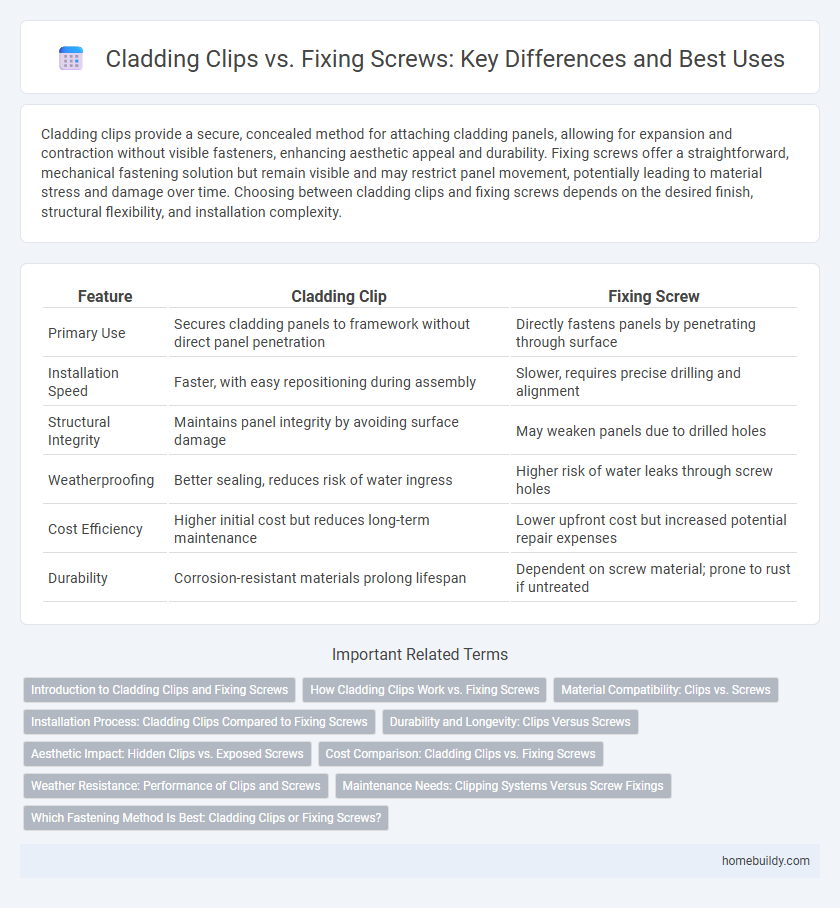Cladding clips provide a secure, concealed method for attaching cladding panels, allowing for expansion and contraction without visible fasteners, enhancing aesthetic appeal and durability. Fixing screws offer a straightforward, mechanical fastening solution but remain visible and may restrict panel movement, potentially leading to material stress and damage over time. Choosing between cladding clips and fixing screws depends on the desired finish, structural flexibility, and installation complexity.
Table of Comparison
| Feature | Cladding Clip | Fixing Screw |
|---|---|---|
| Primary Use | Secures cladding panels to framework without direct panel penetration | Directly fastens panels by penetrating through surface |
| Installation Speed | Faster, with easy repositioning during assembly | Slower, requires precise drilling and alignment |
| Structural Integrity | Maintains panel integrity by avoiding surface damage | May weaken panels due to drilled holes |
| Weatherproofing | Better sealing, reduces risk of water ingress | Higher risk of water leaks through screw holes |
| Cost Efficiency | Higher initial cost but reduces long-term maintenance | Lower upfront cost but increased potential repair expenses |
| Durability | Corrosion-resistant materials prolong lifespan | Dependent on screw material; prone to rust if untreated |
Introduction to Cladding Clips and Fixing Screws
Cladding clips offer a secure and concealed fastening method for exterior panels, ensuring durability and aesthetic appeal by minimizing visible hardware. Fixing screws provide direct mechanical attachment, often used for quicker installation but may result in exposed fixings that affect the facade's sleekness. Choosing between cladding clips and fixing screws depends on factors like weather resistance, load distribution, and maintenance requirements in construction projects.
How Cladding Clips Work vs. Fixing Screws
Cladding clips function by securely fastening panels to a structure through interlocking designs that allow for thermal movement and minimal surface penetration, reducing the risk of damage and improving long-term durability. Fixing screws directly penetrate the material, providing a rigid connection but potentially compromising weather resistance and inducing stress points. The clip system enables easier installation and maintenance, while screws require precise drilling and risk corrosion or loosening over time.
Material Compatibility: Clips vs. Screws
Cladding clips are typically made from stainless steel or aluminum alloys, ensuring superior corrosion resistance when used with metal or composite panels, whereas fixing screws often vary in material and may corrode if not matched properly with the cladding substrate. Clips provide non-penetrating attachment, preserving the integrity of materials like fiber cement or composite panels, while screws penetrate and risk damaging or compromising moisture barriers. Selecting clips over screws enhances material compatibility by reducing galvanic corrosion and maintaining the long-term durability of the cladding system.
Installation Process: Cladding Clips Compared to Fixing Screws
Cladding clips offer a faster and more precise installation process compared to fixing screws, as clips allow for consistent spacing and alignment without the need for pre-drilling holes. The clip system reduces installation time by eliminating the risk of uneven surfaces and minimizing manual adjustments during assembly. Fixing screws require multiple steps including measurement, drilling, and screwing, which increase labor costs and the potential for material damage.
Durability and Longevity: Clips Versus Screws
Cladding clips offer superior durability compared to fixing screws due to their corrosion-resistant materials and ability to accommodate thermal expansion without compromising structural integrity. While fixing screws may corrode over time and loosen under stress, cladding clips maintain secure attachment, enhancing the building envelope's longevity. This results in reduced maintenance costs and improved long-term performance for exterior cladding systems.
Aesthetic Impact: Hidden Clips vs. Exposed Screws
Cladding clips provide a cleaner, more streamlined appearance by concealing fixings behind the panels, significantly enhancing the facade's aesthetic appeal. In contrast, fixing screws remain visible on the surface, which can disrupt the uniformity and visual flow of the cladding system. Choosing hidden cladding clips improves the overall architectural design by maintaining smooth, uninterrupted surfaces.
Cost Comparison: Cladding Clips vs. Fixing Screws
Cladding clips generally offer a more cost-effective solution compared to fixing screws due to reduced labor time and minimized material waste. While fixing screws may have a lower initial unit price, the increased installation complexity and potential for damage to cladding panels can raise overall project costs. Evaluations consistently show cladding clips enable faster installations and lower long-term expenses, making them an economically advantageous choice for facade systems.
Weather Resistance: Performance of Clips and Screws
Cladding clips exhibit superior weather resistance compared to fixing screws due to their corrosion-resistant materials and innovative design that minimize water infiltration and prevent rust. Unlike screws, which can loosen and degrade over time under harsh weather conditions, clips provide consistent secure fastening with enhanced durability against UV exposure and moisture. This makes cladding clips the preferred choice for maintaining facade integrity and longevity in extreme climates.
Maintenance Needs: Clipping Systems Versus Screw Fixings
Cladding clips offer streamlined maintenance by enabling easy removal and replacement of panels without damaging the facade, unlike fixing screws which often require unscrewing that may strip threads or deform materials. The use of clips reduces repair time and costs since panels can be accessed individually without disturbing adjacent elements. Maintenance efficiency is enhanced by the resilience of clip systems to weathering, minimizing long-term structural wear compared to screw fixings prone to corrosion or loosening.
Which Fastening Method Is Best: Cladding Clips or Fixing Screws?
Cladding clips provide a more secure and concealed fastening method compared to fixing screws, reducing the risk of water penetration and improving the facade's aesthetic appeal. Fixing screws, while easier to install, can compromise the integrity of cladding panels by creating direct holes and increasing maintenance needs. For long-term durability and clean finishes, cladding clips are generally the superior fastening choice.
cladding clip vs fixing screw Infographic

 homebuildy.com
homebuildy.com